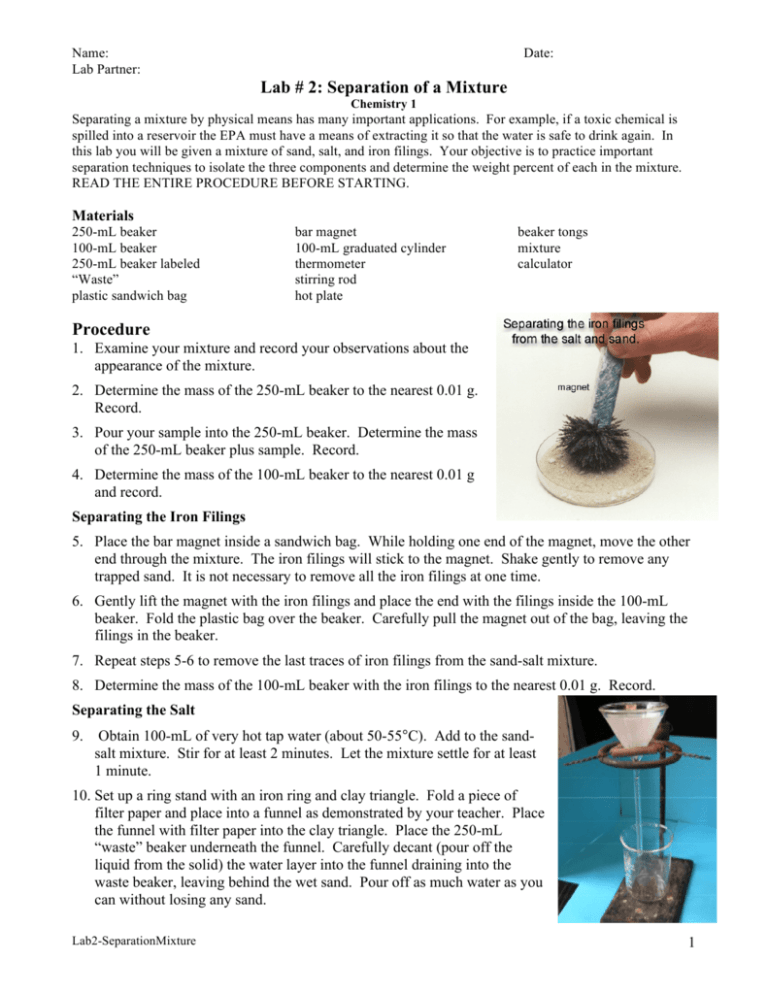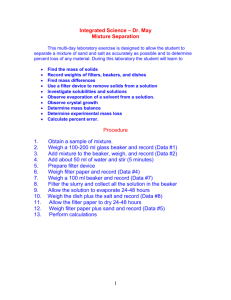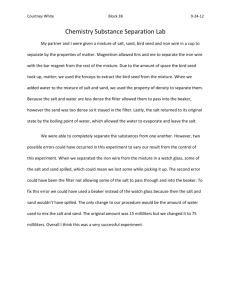Lab # 2: Separation of a Mixture Procedure
advertisement

Name: Lab Partner: Date: Lab # 2: Separation of a Mixture Chemistry 1 Separating a mixture by physical means has many important applications. For example, if a toxic chemical is spilled into a reservoir the EPA must have a means of extracting it so that the water is safe to drink again. In this lab you will be given a mixture of sand, salt, and iron filings. Your objective is to practice important separation techniques to isolate the three components and determine the weight percent of each in the mixture. READ THE ENTIRE PROCEDURE BEFORE STARTING. Materials 250-mL beaker 100-mL beaker 250-mL beaker labeled “Waste” plastic sandwich bag bar magnet 100-mL graduated cylinder thermometer stirring rod hot plate beaker tongs mixture calculator Procedure 1. Examine your mixture and record your observations about the appearance of the mixture. 2. Determine the mass of the 250-mL beaker to the nearest 0.01 g. Record. 3. Pour your sample into the 250-mL beaker. Determine the mass of the 250-mL beaker plus sample. Record. 4. Determine the mass of the 100-mL beaker to the nearest 0.01 g and record. Separating the Iron Filings 5. Place the bar magnet inside a sandwich bag. While holding one end of the magnet, move the other end through the mixture. The iron filings will stick to the magnet. Shake gently to remove any trapped sand. It is not necessary to remove all the iron filings at one time. 6. Gently lift the magnet with the iron filings and place the end with the filings inside the 100-mL beaker. Fold the plastic bag over the beaker. Carefully pull the magnet out of the bag, leaving the filings in the beaker. 7. Repeat steps 5-6 to remove the last traces of iron filings from the sand-salt mixture. 8. Determine the mass of the 100-mL beaker with the iron filings to the nearest 0.01 g. Record. Separating the Salt 9. Obtain 100-mL of very hot tap water (about 50-55°C). Add to the sandsalt mixture. Stir for at least 2 minutes. Let the mixture settle for at least 1 minute. 10. Set up a ring stand with an iron ring and clay triangle. Fold a piece of filter paper and place into a funnel as demonstrated by your teacher. Place the funnel with filter paper into the clay triangle. Place the 250-mL “waste” beaker underneath the funnel. Carefully decant (pour off the liquid from the solid) the water layer into the funnel draining into the waste beaker, leaving behind the wet sand. Pour off as much water as you can without losing any sand. Lab2-SeparationMixture 1 Recovering the Sand 11. Place the beaker containing the wet sand on a hot plate set to “medium”. Heat until the sand appears dry and free-flowing, about 5 minutes. Remove the beaker from the hot plate using beaker tongs and let it sit until cool enough to touch. 12. Determine the mass of the beaker plus sand to the nearest 0.01 g. Record. Observations. Record your observations about the physical appearance of the mixture. Data Table 1. Mass of 250-mL beaker g 2. Mass of 250-mL beaker + sample g 3. Mass of 100-mL beaker g 4. Mass of 100-mL beaker + iron filings g 5. Mass of 250-mL beaker + dried sand g Calculations. Show ALL your work. The calculation for question 1 is set up for you; show your subsequent calculations in a similar manner. 1. Calculate the mass of your sample. mass of 250-mL beaker + sample: _______________ − mass of 250-mL beaker: _______________ = mass of sample: _______________ 2. Calculate the mass of the recovered iron filings. 3. Calculate the mass of the recovered, dry sand. Lab2-SeparationMixture 2 4. The mixture contained iron filings, sand, and salt. Calculate the mass of salt that must have been in the mixture. Show your work. 5. What was the percent by mass of each component of the mixture? Show your calculations. Iron filings, percent of total Sand, percent of total Salt, percent of total 6. Percent yield is a common way to evaluate the amount of product you have obtained through laboratory work. Percent yield is determined in the following manner: For the actual amount of each component, use the amount of each that you were able to isolate. For the theoretical amount of product isolated, I used exactly 3.00 g of Fe, 8.00 g of sand, and 5.00 g of salt Show the calculation neatly in the space provided. Analysis Questions 1. Draw a pie chart showing the percent composition of the mixture. Label the wedges. Lab2-SeparationMixture 3 2. Suppose a lab group reports a percent yield of sand of 105%. Is it really possible to collect more sand than was originally present? What is a possible explanation for the “extra” product? Do not consider calculation mistakes; think about the procedure used. 3. Suppose a lab group reports a percent yield of 90% of salt. What is a possible explanation for the “missing” product? Do not consider calculation mistakes; think about the procedure used. 4. Think about the lab procedure and what you know about types of mixtures. a. Name one heterogeneous mixture present in this lab. ____________________ b. Name one homogeneous mixture present in this lab. ____________________ c. Name one pure substance present in this lab. ____________________ 5. Where did the salt that was in the original mixture end up? 6. Did you separate the iron filings, salt, and sand by taking advantage of the three materials’ different physical properties or chemical properties? Explain. Lab2-SeparationMixture 4




